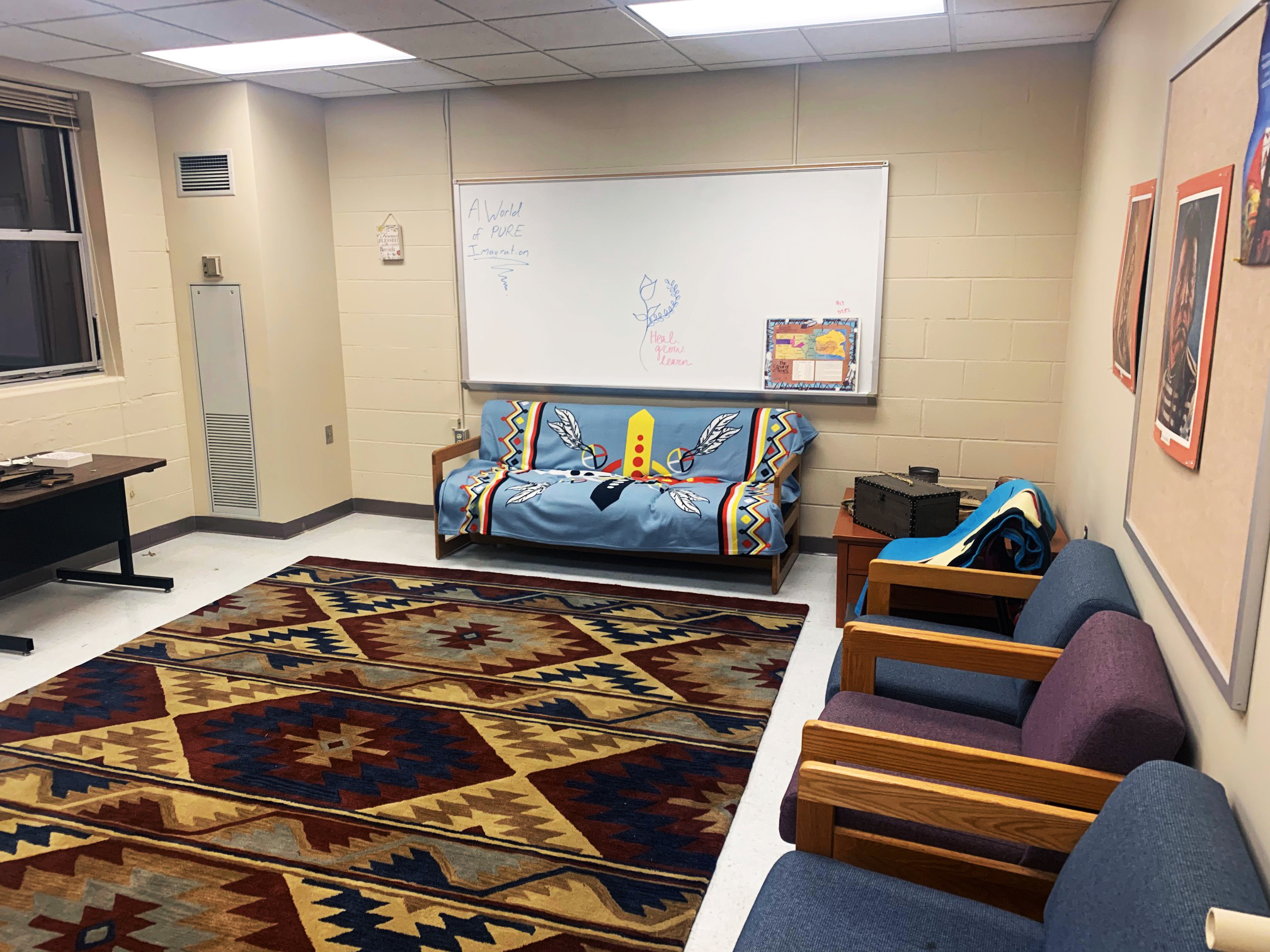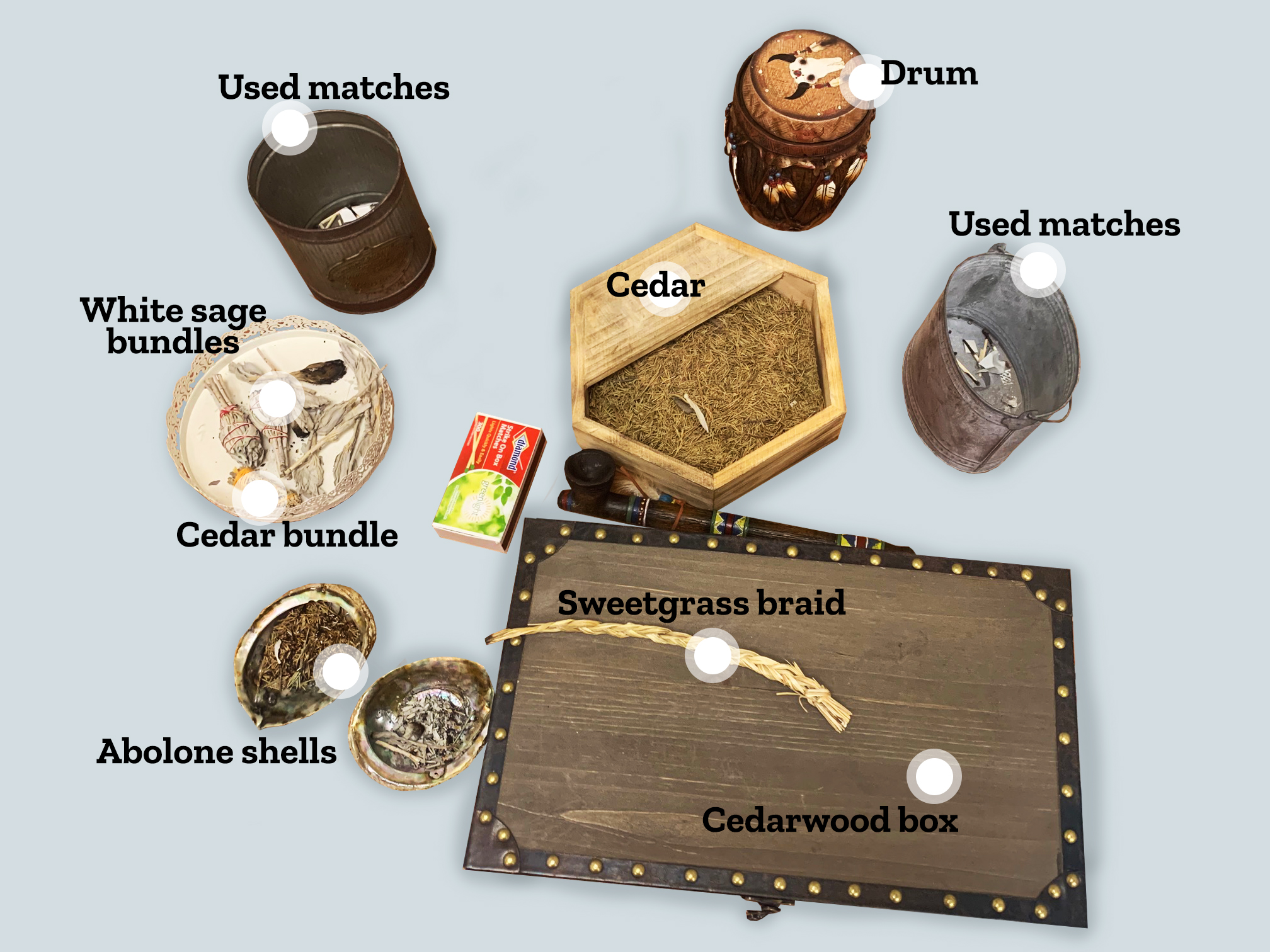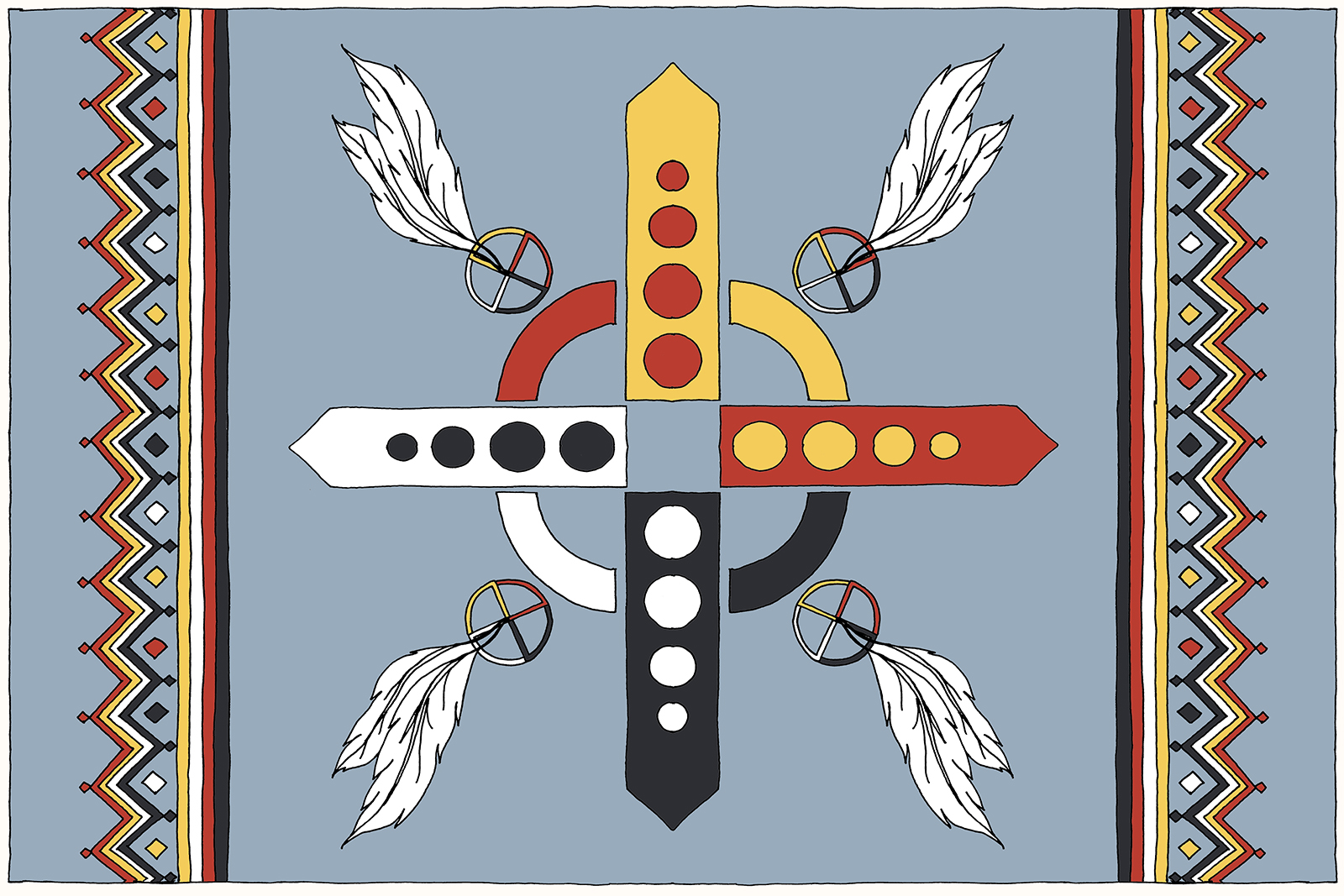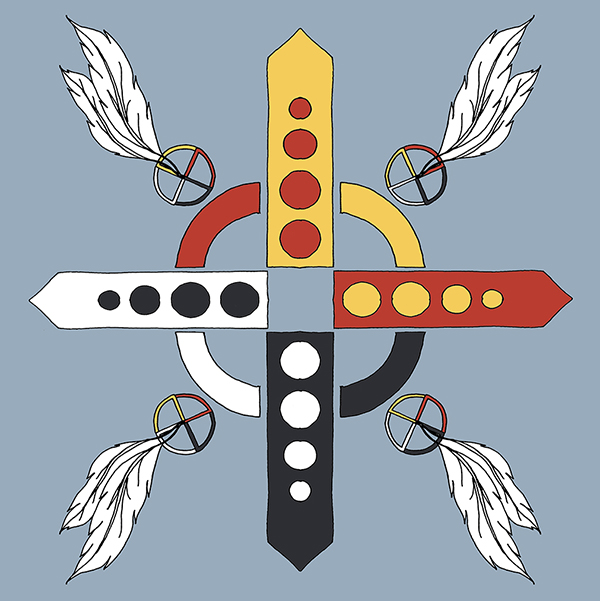Pulling sage leaves from a stem, Haskell Indian Nations University junior Steve Laravie begins to rub the leaves together into a ball. He holds the compact sphere in his hands. He’s in one of the school’s many designated smudge rooms. He breathes in the sage four times. Then he lights it. As the leaves begin to smoke, he grabs that smoke, cupping it and wiping it all over his body and into his mind. Through this ceremony, Laravie feels centered and connected to the Creator.
Haskell Indian Nations University fosters Indigenous culture, languages, and traditions. It serves as Kansas’ only tribal college and resides in Lawrence, Kansas, attracting about 789 students, like Laravie. These students enjoy access to rooms where they can practice and engage in various personal ceremonies for healing and spiritual connection. In fact, on campus, one room per dorm serves as a designated area for prayer and cleansing rituals. The room is about the size of an average dorm with several cushioned chairs and a couch. The university also provides medicines for the students to use in the smudge rooms such as sage, cedar, and sweetgrass. Some students bring their own herbs because each nation has its own ceremonies for praying and healing. When burned, different medicines are used to ignite specific energies. Through the use of those medicines, the smudging room transforms into a sacred space. “The energy in the room is good. And it seems like a place that is very much taken care of and cared about by a lot of people here,” says Laravie, who is Lakota, Dakota, and Ponca. Although the room is called a smudge room, Laravie prefers to use the words “cleaning” or “cleansing” instead. To him, the word “smudging” suggests making something dirty, a connotation at odds with the purpose of these ceremonies.
Students at Haskell can go alone or in groups to the smudge room. Students can ask for assistance performing ceremonies or conduct them alone. And singing and beating drums is allowed. These rooms provide refuge for students when they experience difficulties. “Usually, there’s a certain something going on and you want to feel better about it,” Rhonda Levaldo, who is Acoma Pueblo and a professor of media communications at Haskell, says. “It just depends on the person.” With more than 140 nations represented on campus — the three largest coming from the Navajo Nation, Cherokee Nation, and Oglala Sioux Tribe — not every student prays the same way. Christian Indigenous students may not participate in these traditional ceremonies, but the campus also includes a Native American Church club where students and the public can participate in peyote healing ceremonies.

Each dorm at Haskell Indian Nations University, Kansas’s only tribal college, features a room designated for prayer and cleansing, spaces where students can practice personal ceremonies for healing and spiritual connection. Photo courtesy of Jared Nally.
The United States has 32 fully accredited Tribal Colleges and Universities (TCUs). These institutions have been accredited by either the Higher Learning Commission or the Northwest Commission on Colleges and Universities. The Navajo Nation established the first tribal college now known as Diné College in 1968. The Native American self-determination movement of the 1960s informed the creation of TCUs and the Tribal College Movement, which sought to address Indigenous people’s higher-education needs without assimilation. Across the country, about 250,000 students identify as Native American or Alaska Native, and 8.7% of those students attend a TCU and constitute 78% of the student populations at these schools. At TCUs, Indigenous culture and traditions serve as an integral part of the campus community. The campus includes and celebrates Indigenous voices and perspectives through sacred spaces and in their curriculums. These healing spaces — such as smudge rooms — allow students to support their mental health in ways that align with their traditional beliefs. Having access to these ceremonial spaces at TCUs gives students the opportunity to connect or reconnect with their culture and identity. “The ceremonies are part of a person’s culture, and it belongs to the culture,” Michelle Kahn-John, Ph.D., a Diné citizen and professor at the University of Arizona, says. “So it becomes very relevant and very meaningful.”
Ceremony plays a vital role in how many Indigenous people approach comprehensive healing. They approach the concept of wellness from the physical, the mental, the emotional, and the spiritual. TCUs offer traditional Western therapy and counseling, but they also create space and time for activities such as drumming, singing, praying, and chanting. “When we have individuals who are going through trauma, we try to work from the space of not just the emotional or the cognitive,” says Syracuse University Ombudsman Neal Powless, who is a member of the Onondaga Eel Clan. “But we also look at the spiritual space. We look at the physical impact of what’s going on.” Powless says that movement is essential to healing — without action, the energy and the spirit cannot move. Though SU isn’t a land-grant university like its Central New York neighbor, Cornell University, SU’s campus does sit on Onondaga Nation land. As Ombudsman at SU, Powless acts as an independent resource for all SU faculty, staff, and graduate students who need help resolving problems and questions. He, like many Indigenous people, wrestles with the question of whether these healing ceremonies and knowledge should be shared with non-Indigenous people.
“It gives you that opportunity to create those relationships and to establish a greater understanding of the diversity of this land and the beautiful things that come from people.”
Since Western therapy typically involves talking through feelings and struggles, it may not be the most effective healing process for some Indigenous students, particularly when that therapist is not Indigenous themselves. “They have a hard time trusting whether or not [therapists] can understand,” Powless says. “And even in the therapeutic space, they end up at some level having to do what they do at every other space: explaining who they are.” For Indigenous students, that means explaining to therapists centuries of historical trauma and genocide and about 150 years of American and systemic oppression.
Indigenous students face challenges shared by all college students, but between 2015 and 2016, 9.2% of Native Americans and Alaska Natives aged 18 and older experienced serious psychological distress, compared to 3.6 % of white people. Many Indigenous students remain close with their families and find strength in community and culture so being away from home presents additional challenges. “We’re all about kinship and relating to one another,” the Washington editor of Indian Country Today and Diné citizen Jourdan Bennett-Begaye explains. “So then, when that is kind of disrupted, or you’re kind of taken out of that place, it’s part of your identity so you kind of feel lost.” This close bond with their family also compels some students to go home and help when they are needed, and some even drop out of school to go assist their families. The average graduation rate for four-year TCUs is about 24.7% (by comparison, 58% of all students who started public college in the fall of 2010 earned a degree in six years).
At TCUs, the work to keep students mentally, emotionally, and physically healthy includes a great range of initiatives varying from school to school. Diné College in Tsaile, Arizona features spaces and clubs for traditional ceremonies. A hogan, a Diné-Navajo sacred and ceremonial structure for traditional prayers, sits on campus. Students, faculty, and staff can use this space for prayers such as those for protection. One student organization, Azee’ Bee Nahagha Club of Diné College (formerly called the Native American Church) holds sacred peyote ceremonies. Diné College’s Navajo Language and Culture Specialist and Navajo-Diné citizen Johnnie Bia Jr. says that he helps students hold ceremonies and collaborates with them whenever he can. The college also provides ceremonial grounds for the Native American Church.
And at Haskell, Laravie uses the smudging room for drumming and singing. There’s no sign-in sheet to use these rooms. Typically, a residential advisor oversees the opening and closing of the spaces. Sometimes Laravie sings alone, and other times he brings friends along. They’ll sing whatever songs strike them in the moment. Thanks to the diversity of nations at Haskell, the songs Laravie sings are different from those his friends in different nations sing. But when they come together, they’re able to learn from each other. “It gives you that opportunity to create those relationships and to establish a greater understanding of the diversity of this land and the beautiful things that come from people,” he says. For Laravie, these spaces provide a place where he and his peers can focus on healing. He believes these spaces and ceremonies are an integral part of how he supports his mental well-being at school.

Haskell India Nations University provides medicines for its 789 students to use in cleansing and healing ceremonies such as sage, cedar, and sweetgrass, but some students bring their own because each nation possesses its own rituals. Photo illustration by Ali Harford.
Similarly, at Diné College, the traditional Navajo sweat lodge serves as a space for prayers and songs. In that space, women and men are separated, and a traditionalist facilitates the ceremony. “Even in that setting too, there’s basically a lot of mental-health awareness that goes on with teaching to the physical wellness,” Diné College’s Disability Coordinator and Diné citizen Lavine Blackmountain says. Research supports the mental-health benefits of these ceremonies. Professor Kahn-John, medicine man Anderson Hoskie, and research assistant Berdie Johnson worked on a research project to assess the effects of the traditional Diné ceremony. They measured inflammation and emotional distress before and after a Diné healing ceremony. Kahn-John and her team recruited 25 participants. After 30 days, the team checked in on the participants and found that they all improved emotionally and mentally. The intensity of the healing over that period of time surprised Kahn-John. “There’s a reason [ceremony] continues to exist,” Kahn-John says. “People believe in it, and people have recognized that it is effective.”
“It takes care of our spirit, our physical, our mental well-being.”
Beyond healing, these ceremonies provide access and understanding to Indigenous students who grow up with little or no exposure to traditional or cultural knowledge. TCUs can help those students better understand themselves and their cultural identities and answer questions they may have. Bia Jr. remembers one student who, after learning more about his culture, came to embrace his Diné-Navajo identity. That student grew his hair out and wore traditional garb and mocassins. “To come back and reclaim yourself — that’s how a lot of my students here feel,” Bia Jr. says. “They come to school, and they get some sense of guidance, like a spiritual awakening.” Access to traditional ceremonies and access to curriculums such as those at TCUs provide avenues for students to understand their culture, stories, and heritage. Students often go to Bia Jr. for help with the Navajo language or for a better understanding of Diné-Navajo traditions. Diné College also has a School of Diné Studies and Education that offers students an opportunity to earn a certificate in Navajo cultural arts, a bachelor’s degree in Diné studies, and a bachelor’s in the Navajo language.
As an Indigenous and American Indian studies major, Laravie has devoted his academic career to learning about tribal history and America’s relationship with Indigenous communities. For Laravie, their ceremonies and prayers are the roots of Indigenous people in this land. “It takes care of our spirit, our physical, our mental well-being,” Laravie explains. “The ceremonies are what keep us attached to who we are and help us understand the life that we walk through, the life we live in, and the life that we will leave here when our time is ready.”


